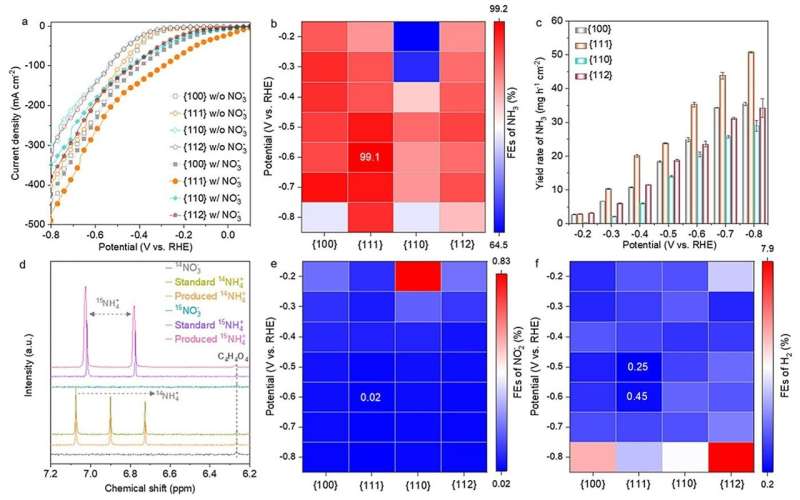This article has been reviewed according to Science X's editorial process and policies. Editors have highlighted the following attributes while ensuring the content's credibility:
fact-checked
peer-reviewed publication
trusted source
proofread
Insights into spinel cobalt oxides may lead to efficient ammonia synthesis

Researchers have made a significant breakthrough in the development of catalysts for the electrochemical nitrate reduction reaction (eNO3RR) to ammonia, a process that has broad implications for sustainable energy, agriculture, and industrial applications. The study is published in the journal ACS Nano.
Ammonia, a critical component in global food production, also holds promise as a zero-carbon fuel due to its high energy density, clean combustion products, and established infrastructure for storage and transportation. However, the current method of producing ammonia, the Haber-Bosch process, is energy-intensive and accounts for about 1.8% of global CO2 emissions.
In their recent study, the research team focused on spinel cobalt oxides (Co3O4), a promising class of catalysts for eNO3RR due to their low cost, high activity, and selectivity.
The team synthesized various Co3O4 nanostructures with different crystallographic facets—{100}, {111}, {110}, and {112}—to investigate how these facets influence the catalyst's performance in ammonia production. The study revealed that the {111} facet of Co3O4 exhibited superior performance, achieving an impressive ammonia Faradaic efficiency of 99.1% and a yield rate of 35.2 mg h-1 cm-2.
"Our findings show that the {111} facet of Co3O4 is effective in transforming nitrate to ammonia," said Dr. Heng Liu, the co-first author of the paper and a Specially Appointed Assistant Professor at the Advanced Institute for Materials Research (WPI-AIMR), Tohoku University.
"This is due to the rapid formation of oxygen vacancies and Co(OH)₂ on this facet, which significantly enhances the catalyst's performance."

In addition, the researchers discovered that the catalyst went through a transformation process during the reaction, evolving from Co3O4 to a structure with oxygen vacancies, then to a Co3O4−x-Ov/Co(OH)2 hybrid, and finally stabilizing as Co(OH)2. This process was most pronounced on the {111} facet, contributing to its superior performance.
"The structural changes we observed are crucial for understanding the catalyst's activity," added Professor Hao Li, corresponding author of the paper and an associate professor at WPI-AIMR. "These insights will help us design more efficient catalysts by optimizing the exposed facets."
Ammonia's importance extends beyond agriculture, as it is a potential zero-carbon fuel and a key player in energy conversion and storage technologies. The eNO3RR offers a sustainable alternative to the Haber-Bosch process, transforming nitrate waste into valuable ammonia while aiding environmental remediation.

"This research lays a solid foundation for the development of more efficient, sustainable catalysts," states Li. "As we move forward, our goal is to control the final phases of the catalyst's transformation to further enhance its activity, selectivity, and stability."
This breakthrough in understanding and optimizing Co3O4 catalysts could pave the way for cleaner and more sustainable industrial processes, contributing to the global efforts to achieve carbon neutrality by the 2050s.
More information: Anquan Zhu et al, Facet-Dependent Evolution of Active Components on Spinel Co3O4 for Electrochemical Ammonia Synthesis, ACS Nano (2024). DOI: 10.1021/acsnano.4c06637
Journal information: ACS Nano
Provided by Tohoku University





















